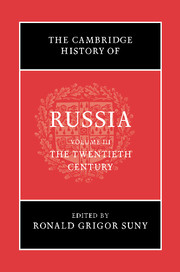Book contents
- Frontmatter
- Introduction
- 1 Reading Russia and the Soviet Union in the twentieth century: how the ‘West’ wrote its history of the USSR
- Part I Russia and the Soviet Union: The Story through Time
- Part II Russia and the Soviet Union: Themes and Trends
- 14 Economic and demographic change: Russia’s age of economic extremes
- 15 Transforming peasants in the twentieth century: dilemmas of Russian, Soviet and post-Soviet development
- 16 Workers and industrialization
- 17 Women and the state
- 18 Non-Russians in the Soviet Union and after
- 19 The western republics: Ukraine, Belarus, Moldova and the Baltics
- 20 Science, technology and modernity
- 21 Culture, 1900–1945
- 22 The politics of culture, 1945–2000
- 23 Comintern and Soviet foreign policy, 1919–1941
- 24 Moscow’s foreign policy, 1945–2000: identities, institutions and interests
- 25 The Soviet Union and the road to communism
- Bibliography
- Index
- References
22 - The politics of culture, 1945–2000
from Part II - Russia and the Soviet Union: Themes and Trends
Published online by Cambridge University Press: 28 March 2008
- Frontmatter
- Introduction
- 1 Reading Russia and the Soviet Union in the twentieth century: how the ‘West’ wrote its history of the USSR
- Part I Russia and the Soviet Union: The Story through Time
- Part II Russia and the Soviet Union: Themes and Trends
- 14 Economic and demographic change: Russia’s age of economic extremes
- 15 Transforming peasants in the twentieth century: dilemmas of Russian, Soviet and post-Soviet development
- 16 Workers and industrialization
- 17 Women and the state
- 18 Non-Russians in the Soviet Union and after
- 19 The western republics: Ukraine, Belarus, Moldova and the Baltics
- 20 Science, technology and modernity
- 21 Culture, 1900–1945
- 22 The politics of culture, 1945–2000
- 23 Comintern and Soviet foreign policy, 1919–1941
- 24 Moscow’s foreign policy, 1945–2000: identities, institutions and interests
- 25 The Soviet Union and the road to communism
- Bibliography
- Index
- References
Summary
During the more than half a century covered in this chapter, the Soviet Union experienced a bewildering array of changes, up to and including its own demise. The final years of Stalin’s life and rule, when the country had to regenerate itself after the devastation of the Second World War, involved major cultural repressions amid a climate of isolationism and xenophobia. Between Stalin’s death in 1953 and the mid-1960s, Soviet officialdom shed its most tyrannical aspects, and despite frequent reimposition of cultural controls, artistic creativity flourished. Brezhnev’s reign curtailed much of the dynamism characteristic of the Thaw, whose suppressed energies re-emerged during Gorbachev’s five years of perestroika and glasnost’. Finally, after the upheavals that ended Gorbachev’s rule, Russia now vies for attention and profit in a world market. In slightly more than half a century, then, the society has gone from absolute political centralisation to substantial if jagged decentralisation, from state-planned mega-economic structures to market-dependent enterprises, from power- and prestige-based hierarchies to money-based class structures. Its creative artists, once tacit partners with the state in a contract based on mutual support, must fend for themselves in a difficult and competitive environment.
- Type
- Chapter
- Information
- The Cambridge History of Russia , pp. 605 - 635Publisher: Cambridge University PressPrint publication year: 2006
References
- 1
- Cited by



